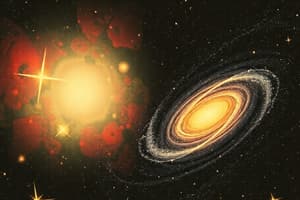Podcast
Questions and Answers
Which of the following is NOT a characteristic of minerals?
Which of the following is NOT a characteristic of minerals?
- Solid form
- Definable chemical composition
- Naturally occurring
- Organic composition (correct)
What type of rock is formed from the solidification of molten material?
What type of rock is formed from the solidification of molten material?
- Sedimentary rock
- Metamorphic rock
- Igneous rock (correct)
- Clastic rock
What distinguishes a plutonic rock from a volcanic rock?
What distinguishes a plutonic rock from a volcanic rock?
- Formed from magma at Earth's surface
- Has no crystalline structure
- Contains only intrusive minerals
- Formed from magma underground (correct)
Which of the following is a type of non-silicate mineral?
Which of the following is a type of non-silicate mineral?
Which property of minerals is measured using the Mohs hardness scale?
Which property of minerals is measured using the Mohs hardness scale?
What is the primary process by which sedimentary rocks are formed?
What is the primary process by which sedimentary rocks are formed?
Which type of metamorphism involves magma rising and altering surrounding rocks?
Which type of metamorphism involves magma rising and altering surrounding rocks?
Which term refers to the difference in angle between geographic north and magnetic north?
Which term refers to the difference in angle between geographic north and magnetic north?
What is the primary composition of the Earth's outer core?
What is the primary composition of the Earth's outer core?
Which of the following correctly describes the rate of population growth?
Which of the following correctly describes the rate of population growth?
What does the term 'deep time' refer to in geology?
What does the term 'deep time' refer to in geology?
What type of mineral bond involves the sharing of a pair of electrons?
What type of mineral bond involves the sharing of a pair of electrons?
What is the term used for the maximum number of individuals a habitat can support?
What is the term used for the maximum number of individuals a habitat can support?
How is lithification primarily accomplished?
How is lithification primarily accomplished?
Which of the following statements about isotopes is true?
Which of the following statements about isotopes is true?
What is the formula to determine the doubling time of a population?
What is the formula to determine the doubling time of a population?
What is the main basis for the plate tectonics theory established by Wegener's hypothesis of continental drift?
What is the main basis for the plate tectonics theory established by Wegener's hypothesis of continental drift?
Which process describes the sinking of one plate into a trench due to mantle cooling?
Which process describes the sinking of one plate into a trench due to mantle cooling?
What are magnetic reversals useful for in geological studies?
What are magnetic reversals useful for in geological studies?
Which type of deformation occurs when rocks do not return to their original shape after stress is removed?
Which type of deformation occurs when rocks do not return to their original shape after stress is removed?
What is represented by the term 'epicenter' in the context of earthquakes?
What is represented by the term 'epicenter' in the context of earthquakes?
Which type of plate interaction is characterized by tectonic plates moving apart?
Which type of plate interaction is characterized by tectonic plates moving apart?
What dynamic process helps drive tectonic plate motion according to the convection cell model?
What dynamic process helps drive tectonic plate motion according to the convection cell model?
Which type of fault movement involves slow, gradual slipping without significant earthquake activity?
Which type of fault movement involves slow, gradual slipping without significant earthquake activity?
What describes the movement of the hanging wall in a normal fault?
What describes the movement of the hanging wall in a normal fault?
Which type of seismic wave can pass through both solids and liquids?
Which type of seismic wave can pass through both solids and liquids?
What is the primary factor that distinguishes mafic lava from felsic lava?
What is the primary factor that distinguishes mafic lava from felsic lava?
Which phenomenon involves soil becoming liquid-like due to earthquake conditions?
Which phenomenon involves soil becoming liquid-like due to earthquake conditions?
What is measured using the logarithmic Richter scale?
What is measured using the logarithmic Richter scale?
What characteristic makes intermediate lava distinct?
What characteristic makes intermediate lava distinct?
What is a likely cause of magma formation related to geological processes?
What is a likely cause of magma formation related to geological processes?
Which of the following is NOT a type of earthquake hazard?
Which of the following is NOT a type of earthquake hazard?
Flashcards are hidden until you start studying
Study Notes
Planet and Population
-
Accretion: Gravitational collection of dust and debris contributing to planet formation.
-
Earth's Layers:
- Crust: Composed of oxygen and silicon.
- Mantle: Composed of iron, magnesium, silicon, and oxygen.
- Core: Made of iron and nickel, with a liquid outer core generating the magnetic field and a solid inner core.
-
Origin of Life: Earliest life forms, such as cyanobacteria, introduced oxygen into Earth's atmosphere.
-
Deep Time Concept: Thinking in terms of millions to billions of years is essential in geology.
-
Population Growth Rate: Calculated as the change in population number over time, with exponential growth represented as a J-shaped curve.
-
Doubling Time Formula: D = 70/r, where D is the doubling time and r is the growth rate.
-
Logistic Growth: Population growth that slows as size increases, forming an S-shaped curve; capped by carrying capacity (K).
Rocks and Minerals
-
Lithification: The process of compaction and cementation that transforms sediments into solid rock.
-
Isotopes: Variants of elements differing in neutron number; for example, C-12 and C-14, with C-12 being predominant.
-
Half-Life: Time needed for half of the radioactive isotope to decay; useful in dating fossils up to 50,000 years old.
-
Mineral Characteristics: Must be naturally occurring, inorganic, solid, with a definable chemical composition and crystalline structure.
-
Physical Properties of Minerals:
- Color, streak, hardness (Mohs hardness scale), cleavage, fracture, luster, and specific gravity.
-
Types of Minerals:
- Silicates: Contain silicon and oxygen (e.g., Quartz).
- Non-Silicates: Include carbonates (e.g., Limestone), sulfates (e.g., Pyrite), oxides, and native elements.
-
Rock Types:
- Igneous Rocks: Result from molten material cooling, classified as:
- Plutonic (e.g., Granite): Formed underground.
- Volcanic (e.g., Basalt): Formed at or above the surface.
- Sedimentary Rocks: Form through cementation, organic accumulation, or mineral precipitation.
- Metamorphic Rocks: Result from solid-state changes due to pressure and temperature, exhibiting either foliation or non-foliation.
- Igneous Rocks: Result from molten material cooling, classified as:
Plate Tectonics
-
Continental Drift: Hypothesis by Wegener suggesting continents moved over geological time, paving the way for plate tectonics.
-
Convection Currents: Warm fluids rising within Earth push seafloor apart at mid-ocean ridges.
-
Subduction Process: One tectonic plate sinks into the mantle at a trench while another plate remains at the surface.
-
Magnetic Stratigraphy: Movement and reversal of magnetic poles documented through geological records on the ocean floor.
-
Plate Interactions:
- Divergent Margins: Plates move apart, creating new crust.
- Convergent Margins: Plates collide, leading to subduction and crust destruction.
- Transform Margins: Plates slide horizontally past each other.
Earthquakes
-
Earthquake Definition: Release of built-up stress in the lithosphere along faults.
-
Fault Types:
- Creep (slow movement), with walls classified as hanging and foot walls.
- Normal Faults (hanging wall moves up), Reverse Faults (hanging wall moves down), and Strike-Slip Faults (horizontal movement).
-
Seismic Waves:
- Body Waves: Include P waves (compressional, fastest) and S waves (shear, cannot pass through liquids).
- Surface Waves: Travel along the Earth's surface and inflict greater damage.
-
Magnitude Measurement:
- Using the logarithmic Richter scale for magnitude and Mercalli scale for intensity.
-
Earthquake Hazards: Include tsunamis, landslides, aftershocks, and soil liquefaction.
Volcanoes
-
Viscosity: The measure of a fluid’s resistance to flow, influenced by temperature and silica content.
-
Magma Composition: Key elements are silica, iron, and magnesium.
- Mafic Magma: Low silica, high mineral content, and low viscosity.
- Felsic Magma: High silica, low mineral content, and high viscosity.
-
Magma Formation: Occurs due to reduction in pressure or addition of fluids from subducting plates.
-
Eruption Styles: Include fissure eruptions where magma rises through cracks in the lithosphere.
Studying That Suits You
Use AI to generate personalized quizzes and flashcards to suit your learning preferences.




